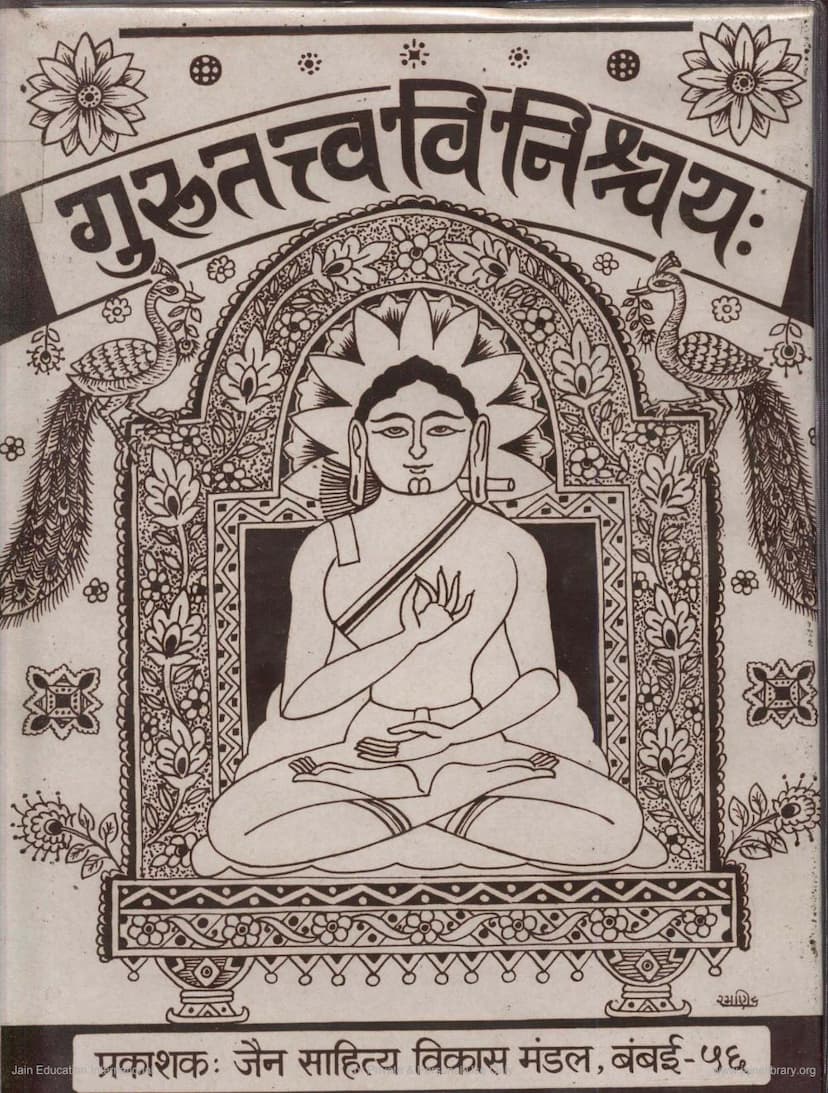Gurutattvavinischay Part 1
Added to library: September 1, 2025

Summary
Here's a comprehensive summary of "Gurutattvavinischay Part 1" (Guru Tattva Vinischaya Part 1) by Yashovijay Upadhyay and Rajshekharsuri, based on the provided text.
Book Title: Gurutattvavinischay Part 1 Author(s): Yashovijay Upadhyay, Rajshekharsuri Publisher: Jain Sahitya Vikas Mandal, Mumbai
Overall Purpose:
This book, a Gujarati translation and commentary, aims to elucidate the profound significance and teachings of the Guru Tattva (the principle of the Guru) within Jainism. It emphasizes the indispensable role of a true Guru in the spiritual journey towards liberation (Moksha). The work is a testament to the philosophical depth and scholarly tradition of Jainism, specifically highlighting the contributions of Mahopadhyaya Yashovijayji, a renowned Jain scholar.
Key Themes and Content (Based on the provided sections):
The text, particularly the initial sections (Ullas 1-2), delves deeply into the Guru Tattva, its importance, and the various facets of the Guru-disciple relationship. Here's a breakdown of the key themes:
-
The Supreme Importance of the Guru:
- The text consistently stresses that without a Guru, spiritual progress is impossible. The Guru is presented as the sole refuge in the turbulent ocean of Samsara (the cycle of birth and death).
- The Guru is likened to a physician who heals the disease of worldly suffering (Sansara-jwar) with the medicine of the Triple Jewels (Samyak Darshan, Samyak Gyan, Samyak Charitra).
- The Guru is also compared to a lamp that dispels the darkness of ignorance and illusion, illuminating the path to spiritual enlightenment.
-
The Guru's Grace and Spiritual Attainment:
- The text highlights that through the Guru's grace and guidance, even the most fallen or sinful beings can attain the highest spiritual states, even liberation.
- The Guru's teachings and guidance are essential for the proper practice of vows, scriptures, and spiritual disciplines.
-
The Guru's Knowledge and Teachings:
- The Guru's knowledge is described as all-encompassing, capable of dispelling all doubts and illuminating the nature of reality.
- The importance of studying and understanding the scriptures under the guidance of a qualified Guru is emphasized.
-
The Guru-Disciple Relationship:
- GURUKULVAS (Living with the Guru): The text advocates for the traditional practice of Gurukulvas, emphasizing its importance as the first step in spiritual discipline. This involves residing with the Guru, learning from them directly, and following their instructions.
- Types of Gurus and Disciples: The text implicitly or explicitly discusses the qualities of a true Guru and the necessary reverence and obedience of a disciple. It also touches upon the concept of different types of gurus based on their knowledge and lineage.
- The Guru's Role in Spiritual Growth: The Guru is not merely an instructor but a guide who helps the disciple navigate the complexities of spiritual practice, understand the scriptures, and overcome obstacles.
-
Distinction between Nayas (Perspectives):
- A significant portion of the initial Ullas discusses the interplay and sometimes apparent conflict between the Nishchay Naya (Ultimate Reality perspective) and the Vyavahar Naya (Conventional Reality perspective).
- The text argues for the necessity and validity of both perspectives, demonstrating how Vyavahar Naya (conventional practices, rituals, and societal norms) serves as a crucial stepping stone towards understanding and realizing Nishchay Naya (ultimate truth).
- It clarifies that Vyavahar Naya, when understood correctly, does not contradict Nishchay Naya but rather facilitates its attainment. The text uses analogies and examples to explain this complex philosophical concept.
-
The Guru's Role in Rituals and Practices:
- The text emphasizes that various Jain practices and rituals, when performed under the guidance of a Guru, are infused with spiritual significance. The Guru's role is to guide the disciple in the proper application of these practices.
-
The Virtues of the Guru:
- The text extols the virtues of the Guru, including their profound knowledge, unwavering adherence to principles, compassion, fearlessness, and their ability to dispel ignorance and suffering.
- Mahopadhyaya Yashovijayji's own life and vast literary output are implicitly presented as an example of these virtues.
-
Scholarly Approach:
- The work is characterized by its logical reasoning, the use of scriptural references, philosophical analysis, and the presentation of arguments and counter-arguments (Purvapaksha and Uttarapaksha) to establish the truth of the Guru Tattva.
- The detailed explanation of concepts like Nayas (perspectives) and the meticulous breakdown of rituals and practices underscore the text's scholarly nature.
Structure and Style:
- The book is presented in Gujarati, with the original Sanskrit text likely forming the basis, and extensive commentary and interpretation.
- The style is philosophical and argumentative, aimed at providing a clear and convincing understanding of the Guru Tattva.
- The inclusion of references to other Jain scriptures (like Mahanishith, Panchashaka, Acharanga, etc.) demonstrates the author's deep grounding in the Jain canon.
In essence, "Gurutattvavinischay Part 1" is a foundational text for Jains seeking to understand the central role of the Guru in their spiritual path. It offers a comprehensive philosophical and practical exploration of this essential principle, highlighting the path to true knowledge and liberation as guided by an enlightened Guru.